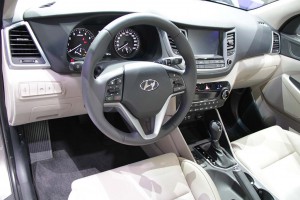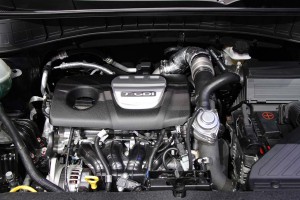Hyundai teased the debut of the 2016 Tucson so well that by the time the media hit the maker’s stand for the unveiling, there was little mystery left. However, the maker rectified that by also debuting its new ix20 MPV as well and two future takes on the Tucson.
The maker also displayed its i20, i30 and i40 models for the public as well. While the new people mover and coupes are important, it’s the 2016 Tucson that is the big show. Hyundai showcased its new technology capabilities with two All-New Tucson fuel efficiency concepts – a 48-volt Hybrid and a Plug-in-Hybrid version – as well as a future connectivity cockpit concept.
“Hyundai Motor has high aspirations for the brand in Europe. The All-New Tucson is a bold new car that brings to life our claim ‘New Thinking, New Possibilities’ and will change perceptions of the brand,” said Jochen Sengpiehl, vice president Marketing at Hyundai Motor Europe.
With a sleeker design that moves even further away from the classic, boxy SUV look of earlier versions, the new Tucson is clearly aimed at building Hyundai’s share of the booming global utility vehicle market.

With a sleeker design that is further away from the boxy SUV look of earlier versions, the Tucson is aimed at building Hyundai’s share of the booming global utility vehicle market.
Among other things, the 2016 Hyundai Tucson will get a new turbocharged 1.6-liter engine. But U.S. buyers won’t get the diesel offered in Europe.
The updated Tucson will pick up on some of the latest Hyundai design cues, such as the signature hexagonal grille, refined by recent offering such as the second-generation Genesis luxury sedan.
“Our new compact SUV will be a big step forward for the Hyundai brand globally,” said Peter Schreyer, president and chief design officer of Hyundai Motor Group, in a statement accompanying the Tucson sketch.
The Tucson was first introduced in 2004 as a 2005 model. The current version was redesigned for the 2010 model-year.
The 2016 revamp underscores the increasing competitiveness of the compact crossover market, which has been flooded by new offerings from both mainstream and luxury brands over the last several years. Small CUVs have become one of the world’s fastest-growing segments and are forecast to grow significantly faster than the rest of global automotive market into the next decade.
(Hyundai sketches tease new Tucson. For more, Click Here.)
Key competitors for the Hyundai Tucson currently include Japanese models like the Toyota RAV4 and Honda CR-V, the domestic Ford Escape – and even sibling brand Kia’s Sportage. Despite being one of the segment’s older products, Tucson U.S. sales increased last year to 47,306.
The 2016 Tucson will be built on an entirely new platform, according to Hyundai. Among other things, that will yield a far more roomy interior. Even with all the seats up, the new ute will offer 18 cubic feet of cargo space in the rear, for example.
The new model is also expected to get a number of new safety features, including an Autonomous Emergency Braking system. It will be able to function in three separate modes, including one that will bring it to an automatic stop if it senses the ute might collide with another vehicle or a pedestrian.

The 2016 Tucson gets either a 133 horsepower 1.6-liter direct-injection four-cylinder package, and that turbocharged I-4 making 174 hp.
(Click Here for details about Hyundai expanding its commercial vehicle reach.)
Additionally, it boasts Lane Keeping Assist System, Rear Traffic Cross Alert, Blind Spot Detection, Speed Limit Information Function and an Active Hood System.
While the Korean carmaker will offer a range of powertrain options around the world, U.S. buyers will have just two picks: a 133 horsepower 1.6-liter direct-injection four-cylinder package, and that turbocharged I-4 making 174 hp. That engine will be paired with a new seven-speed dual-clutch gearbox. It’s the same engine that will be offered in the new Hyundai Veloster Turbo Rally edition.
Actually, Hyundai will offer three powertrains in the U.S. for Tucson buyers, if you include the hydrogen fuel-cell model being offered by select dealers in Southern California.
Additionally, Hyundai’s provided a possible glimpse at what’s next for the Tucson with two new concept vehicles, which are based on the new Tucson. Both concepts showcase possible powertrain technologies for future Hyundai models.
(To see more about Hyundai’s $74 billion investment plan, Click Here.)
The 48V Hybrid especially suits larger cars and SUVs. Its 48-volt lithium-ion battery and 14 PS electric motor boost power by 10% and reduce emissions significantly while the 48V hybrid system costs just a quarter of a full hybrid solution to build.
The Plug-in Hybrid Electric Vehicle (PHEV) concept is able to travel over 30 miles, or 50 km, in all-electric mode and can recharge in as little as two and a half hours (fast charge) and five hours using a standard outlet. The concept is fitted with a 10.7 kWh lithium-ion polymer battery pack, and a 68 PS electric motor, which supports the 115 PS 1.7-liter diesel engine and the seven-speed dual-clutch transmission. Combining these power sources gives the concept car estimated carbon dioxide-emissions of less than 48 g/km.
Paul A. Eisenstein contributed to this report.

